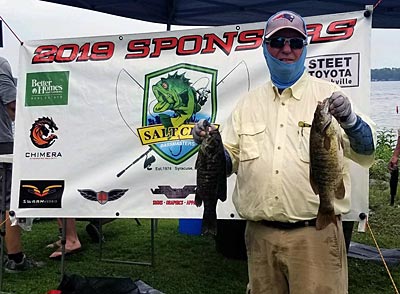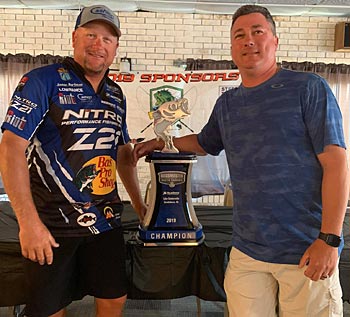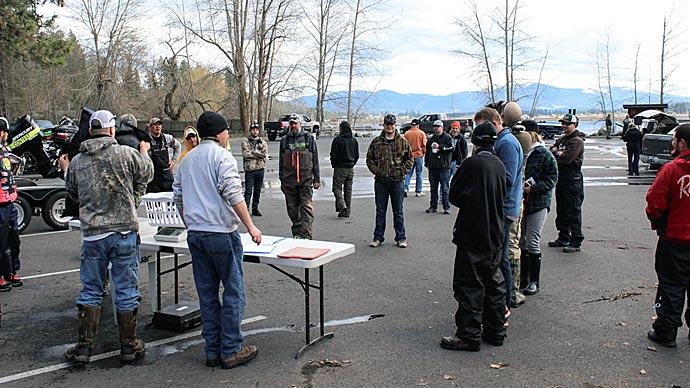
Poll new bass club members, and you’ll hear many reasons why they joined. It may have been the chance for some friendly competition, especially after watching bass tournaments on television. Others want to learn from more experienced anglers. And there are always a few who want more opportunities to get on the water, sharing a boat with anglers they soon will consider friends.
While each is a great reason to pay your membership dues, being part of a bass club is much more. What that includes depends on how a bass club is structured. Some focus on tournaments and handling club business at the ramp before blast-off or after weigh-in. Others concentrate on helping others, whether undertaking environmental efforts, fundraising, or hosting youth bass clubs and community fishing events.
Most bass clubs fall somewhere in between, mixing tournament competition and good deeds. One of those is Syracuse, N.Y.-based Salt City Bassmasters. While its members endure cold winters with piles of lake-effect snow, they are privy to some of the country’s best bass fishing when the weather warms. The Finger Lakes, including Cayuga, is an hour or so to the west. The St. Lawrence River, which Bassmaster named the country’s best bass fishery in 2019, is less than a two-hour drive away. Lake Champlain lies to the east, and Oneida Lake, which has hosted a few Bassmaster Elite Series events, is their front porch.
Salt City had about 50 members in 2019. “We average about three to five new members each year, usually split between boaters and co-anglers,” said Tom Pavlot Jr., the club’s president.
But club membership, at least for Salt City, isn’t linked to boat ownership. It’s about learning and having fun. “Everything we do is to get more guys out fishing,” said Pavlot, who has been a club member for about 30 years. “The guys in the club run the club. They come up with ideas, and if it’s feasible, we do it. It’s such a good group of guys in the club. Lots and lots of good times in Salt City.”
Learning and sharing
Research is the first step in learning about bass fishing in general or specific techniques and lures. And the internet, television, and magazines provide plenty of information. But they lack the one thing a bass club can provide: hands-on learning. And you’ll get plenty as a member.

Seeing lures, techniques, and fishing strategies play out in front of you brings everything you’ve read or watched into focus. Pavlot, who has always competed from the back of the boat, said: “I may be an old dog, but I can still learn a trick or two. Come with an open mind to learn and have fun. That’s what I tell [new members].”
Learning happens off the water, too. Pavlot said post-tournament discussions start at the ramp when the weigh-in is finished, and boats are loaded, and continue at the next monthly meeting, including the top finishers detailing their day. “You aren’t getting that [prize] check from me unless you give up the juice,” he said.
Expect to hear specific details, including how, why, and when the top finishers caught their bass. Comparing that information to your day will reveal what you did right, did wrong, and how to change for the better when confronted with similar conditions again. What you shouldn’t expect to hear is where they caught their bass. That’s one detail that’s given universal protection, especially if you fished with one of the top finishers.
Clubs often draw on members’ talents outside fishing to keep things rolling. Pavlot said one recent new member, for example, volunteered to be Salt City’s treasurer after detailing his experience at other organizations and groups. And a member who specializes in sales and marketing helps find and retain the club’s sponsors. “The guys who join, if they have specialties and want to share it, we use it,” he said.
Competing
Most if not all of your hands-on experience will come through tournament competition. Except for a club’s annual overnight trip or two-day tournament, expect to fish one-day tournaments that are close to home. “You don’t have to take off for a weekend,” Pavlot said. That keeps costs down, and your schedule opens for life’s other important events.

The tournament format is club specific. Some require you have a boat so that everyone can fish by themselves. Most use a partner format, whether choosing your own or matching boaters and co-anglers through a blind draw. They may compete against each other head to head or in separate divisions. If you want to learn, the partner format is for you.
Pavlot said Salt City works to get everyone on the water, searching for additional boaters if more co-anglers have signed up for a tournament. “If we can’t [find boaters], then the first co-anglers out are the first ones drawn in the next tournament,” he said. That has only happened once in the past six years.
Tournament formats are precisely as you see on television, with most clubs going the traditional route of five-bass limits weighed at a central location at the end of the day. Some have embraced the Major League Fishing format, which counts almost every bass caught and immediately released. Salt City, for example, starts with a few MLF-style events, taking advantage of New York’s early catch-and-release bass season, before transitioning to traditional tournaments for the remainder of its nine-tournament season. It ends with a Club Classic for top finishers.
Plan on paying an entry fee for each tournament. Salt City, for example, charges co-anglers $35 and boaters $45, which can be paid online or at the meeting preceding the tournament. Pavlot said most goes to that tournament’s payout, with $5 kept for the Classic payout and some going to the club’s general account.
Helping
Being part of a larger group brings opportunities for more fun and helping others. While fishing will be the focus, your time as a member will find both through club activities such as environmental projects. Salt City, for example, supplies labor for an annual effort to remove invasive water chestnut weeds from the Seneca and Oneida Rivers. It’s a project that the club launched years ago.
You also may be asked to help rear the next generation of anglers. It’s a rewarding experience that helps strengthen the sport you love. While Salt City no longer fields its youth club, Pavlot said members provide boats and time to one run by a nearby club. And they support Take a Soldier Fishing, which treats soldiers from Fort Drum near Watertown, N.Y., to a day of fishing, food, and fun on Oneida Lake each spring.

Club members also improve habitat and access to their local waterways. Pavlot’s club has been named caretaker of the state’s newest launch ramp on Onondaga Lake, whose southern end features views of the Dome, where Syracuse University’s basketball and football teams play. He said members will regularly patrol for litter and manage a fishing-line disposal station. They also will use it for the club’s Wednesday night open tournaments, which are a club fundraiser and an opportunity for members to assemble.
Salt City members organize and staff a winter fishing expo like many clubs across the country. It started small with about 20 vendors inside a fire station. Pavlot said it has since moved to a hotel’s convention center, and more than 30 vendors were expected at the most-recent edition. It has proven to be popular and lucrative. “The money we’re raising, we’re putting back into the club,” he said.
Salt City’s funds were spent on a set of scales for its MLF tournaments, a canopy to create shade at weigh-ins, and a new scale that displays weights on a giant LED screen used at club and Wednesday night tournaments. “It’s a payback to those guys who come out and fish,” Pavlot said.
Salt City’s largest annual expense is its six-man team, which travels to compete against teams from the state’s other bass clubs in a two-day tournament. Pavlot said the club outfits its qualifiers with jerseys, pays the team’s entry fee, and gives each a stipend for the long weekend. A reward for the club’s top finishers from the previous tournament season, it’s the first of many doors that open with a bass-club membership.
Advancing
While there are some independent ones here and there, most bass clubs are affiliated with B.A.S.S. Nation or The Bass Federation. Besides support, these organizations provide you, as a club member, opportunities to fish state-, regional- and national-level tournaments. And on the B.A.S.S. side, that still includes a pathway to qualify for the biggest tournament in bass fishing. “You can still go from the club to the [Bassmaster] Classic if the moon and stars align,” Pavlot said. But it’s a tough road. The late Bryan Kerchal is the only club angler to win the Classic, though fellow Connecticut resident and current Bassmaster Elite Series angler Paul Mueller came close in 2014.
Lessons learned in club tournaments prepare you for other high-level competitions. For example, Salt City members Matt Martin qualified for FLW’s All American, and Randy Yager won a Bassmaster Eastern Invitational on Florida’s Lake Okeechobee. Jamie Hartman, a two-time winner of the Bassmaster Elite Series, was a club member, walking away with one of its MLF-style tournaments on Oneida the year before joining the Elite Series.
But moving up in the fishing world isn’t restricted to competition. For example, Salt City’s Barb Elliot has become the expert on “fizzing” smallmouth caught from deep water, teaching the technique to hundreds of weekend and professional anglers. Mike Cusano, a past Salt City president, became the conservation director and then president of the New York B.A.S.S. Chapter Federation, helping create the state’s catch-and-release season during his tenure. And past Salt City tournament director Chris Bowes now handles those duties for B.A.S.S., overseeing the Opens and some Elite Series events.
Only you can decide where your time as a bass club member takes you. But wherever that is, you’ll learn, have new experiences and make plenty of memories. They’re a big reason why bass clubs remain as popular today as they were when Salt City formed in 1974.




